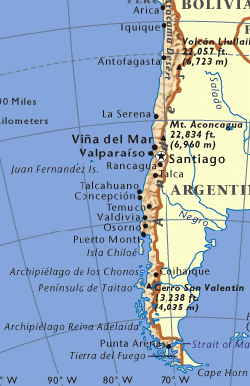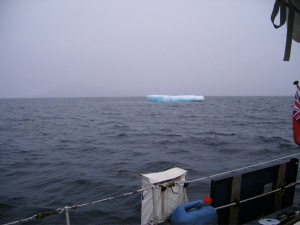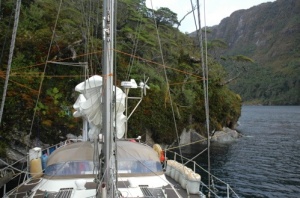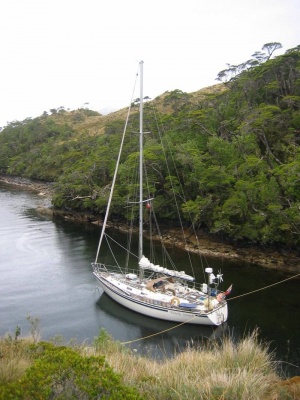Chile
From CruisersWiki
Lighthouse (Talk | contribs) (→External Links) |
|||
| Line 40: | Line 40: | ||
===Charts=== | ===Charts=== | ||
| - | + | The preferred charts for use in Chile are, not unsurprisingly , those produced by the Chilean Hydrographic Service (SHOA) www.shoa.cl. These are produced to a high standard but unfortunately due the age of much of the survey work many of the charts south of the Golfo De Penas exhibit errors in longitude. This error is often in the order of 2 miles. Experience with electronic charts suggests that these charts show the same errors and in many areas the electronic charts give no worthwhile coverage at all. This is yet another reason why nocturnal navigation is not recommended. What every yacht should carry is a copy of the 'Atlas Hidrográfico de Chile' which contains - at a reduced scale - a copy of every Chilean chart. Carry a good magnifying glass and be aware that these charts date from about 2002. Chilean Tide Tables 'Tablas de Marea de la Costa de Chile' should also be carried. | |
| + | |||
| + | Charts and publications are available in, as well as the northern ports, Punta Arenas and Puerto Montt. ''Very'' limited availablity in Puerto Williams if at all. | ||
===Special Navigation Notes=== | ===Special Navigation Notes=== | ||
| - | Night navigation is not to be recommended unless unavoidable. South of Golfo de Penas this is due to the poor quality of the charts in many areas together with the risk from ice. In the vicinity of Tortel/Rio Baker tree trunks can be a problem. North of Melinka the risk is mainly due to fishermen's gear. In all southern areas night navigation involves the risk of being hit by 'rachas' without notice. | + | Night navigation is not to be recommended unless unavoidable. South of Golfo de Penas this is due to the poor quality of the charts in many areas together with the risk from ice. In the vicinity of Tortel/Rio Baker tree trunks can be a problem. North of Melinka the risk is mainly due to fishermen's gear. In all southern areas night navigation involves the risk of being hit by 'rachas' without notice which is as good a way of losing your rig as any. |
===Local Radio Nets=== | ===Local Radio Nets=== | ||
| - | * The Patagonian Cruisers' Net is on 8164 USB at 0900 Chilean Local Time throughout the year. Operated by Wolfgang out of Villarica in the Los Lagos region. | + | * The Patagonian Cruisers' Net is on 8164 USB at 0900 Chilean Local Time throughout the year. Operated by Wolfgang Kirsten out of Villarica in the Los Lagos region. |
* | * | ||
| Line 79: | Line 81: | ||
* [[Punta_Arenas|Punta Arenas]] (Port of entry) | * [[Punta_Arenas|Punta Arenas]] (Port of entry) | ||
* [[Talcahuano|Talcahuano]] (Port of entry) | * [[Talcahuano|Talcahuano]] (Port of entry) | ||
| - | * [[ | + | * [[Valdivia|Valdivia]] (Port of entry) |
* [[Valparaiso|Valparaiso]] (Port of entry) | * [[Valparaiso|Valparaiso]] (Port of entry) | ||
* | * | ||
| Line 95: | Line 97: | ||
It is generally considered that '''Southbound''' passages through the Patagonian Channels may be made with a generally favourable wind at any time of the year. '''Northbound''' late autumn/winter is considered the most settled time while spring/early summer is considered the worst. From May through into September many of the anchorages south of [[Puerto Eden]] are iced up, especially vunerable are ones that have fresh water entering them or have glaciers in the vicinity. | It is generally considered that '''Southbound''' passages through the Patagonian Channels may be made with a generally favourable wind at any time of the year. '''Northbound''' late autumn/winter is considered the most settled time while spring/early summer is considered the worst. From May through into September many of the anchorages south of [[Puerto Eden]] are iced up, especially vunerable are ones that have fresh water entering them or have glaciers in the vicinity. | ||
| - | Good anchorages are normally considered to be those where it is possible to lie to an anchor and two stern lines and where '''''one can make the land one's friend'''''. At least two 'full coil' shore lines should be carried together with two half coils for use where it is possible to run four lines. Polyprop, which floats, is the shore line of choice. While some boats have their shore lines stored on reels others stow their ropes in 'bolsas para verduras' | + | Good anchorages are normally considered to be those where it is possible to lie to an anchor and two stern lines and where '''''one can make the land one's friend'''''. At least two 'full coil' shore lines should be carried together with two half coils for use where it is possible to run four lines.[[Image:tieup.jpg|300px|thumb|right|an anchor and two shore lines = a good night's sleep]] Polyprop, which floats, is the shore line of choice. While some boats have their shore lines stored on reels others stow their ropes in 'bolsas para verduras' |
200 hours/1000 miles of motoring between [[Puerto Montt]] and [[Puerto Williams]] or viceversa is not an unreasonable expectation if any sort of schedule is to be maintained and this should be taken into account when taking diesel (see [[Puerto Eden]] above) . | 200 hours/1000 miles of motoring between [[Puerto Montt]] and [[Puerto Williams]] or viceversa is not an unreasonable expectation if any sort of schedule is to be maintained and this should be taken into account when taking diesel (see [[Puerto Eden]] above) . | ||
| Line 106: | Line 108: | ||
===References & Publications=== | ===References & Publications=== | ||
| - | * Patagonia & Tierra del Fuego Nautical Guide, 2nd Ed. by Mariolina Rolfo & Giorgio Ardrizzi is the standard reference work for the waters from Valdivia , Chile to Mar del Plata, [[Argentina]]. | + | * Patagonia & Tierra del Fuego Nautical Guide, 2nd Ed. by Mariolina Rolfo & Giorgio Ardrizzi is the standard reference work for the waters from Valdivia , Chile to Mar del Plata, [[Argentina]]. http://www.capehorn-pilot.com/ |
* Guia de la Navegación del Yatista para los Canales de Chile / Yachtsman's Navigation Guide to Chilean Patagonia by Alberto Mantellero, 3rd Ed. | * Guia de la Navegación del Yatista para los Canales de Chile / Yachtsman's Navigation Guide to Chilean Patagonia by Alberto Mantellero, 3rd Ed. | ||
| - | * Chile - Arica Desert to Tierra del Fuego, 2nd Ed. by the RCC. covers the waters from Arica to Tierra del Fuego | + | * Chile - Arica Desert to Tierra del Fuego, 2nd Ed. by the RCC. covers the waters from Arica to Tierra del Fuego http://www.imray.com/record.cfm?i_stock_code=898a |
| Line 119: | Line 121: | ||
* http://www.directemar.cl/ | * http://www.directemar.cl/ | ||
* http://www.meteochile.cl/ | * http://www.meteochile.cl/ | ||
| - | * http://www.panoramio.com/user/55032 - Excellent photos of cruising in Chile. | + | * http://www.panoramio.com/user/55032 - Excellent photos of cruising in Chile which are linked to Google Earth. |
===Personal Notes=== | ===Personal Notes=== | ||
Revision as of 23:54, 22 December 2007
Chile
| Chile | |
 Chile | |
 Flag | |
| Capital: | Santiago |
|---|---|
| Language: | Latin American Spanish |
| Currency: | The Chilean Peso, at 12/2007 about 500 peso to the US dollar. |
| More notes about the country | |
Background
The background and history of Chile is best observed on Wikipedia
Climate & Weather
Chile has a wide variety of climatic conditions.
Northern Chile Extreme aridity prevails over the northern part of the country; the average annual rainfall in this region is 0.04 inches. Temperatures are moderate along the coast throughout the year and more extreme inland, especially in the central basin. The average temperatures for the hottest (February) and coldest (July) months are 72F and 60F.
Central Chile (30-40 degrees latitude) has a Mediterranean type of climate, with cool and rainy winters (April to September) but without a completely dry season. Average annual precipitation increases substantially and temperatures decrease toward the south. The average temperatures for the hottest (January) and coldest (July) months at Santiago are 68 F and 46.6F, respectively. The average annual precipitation at Santiago is approximately 15 inches.
Southern Chile The climate of the southern region is cool and rainy the year round. It is characterized by abundant low clouds. The average temperature for the warmest (January) and the coldest (July) months are 57F and 40F respectively.. The average annual precipitation is 119 inches. The changes of the snow line on the westward-facing slopes of the Andes can serve as an indication of the variation in climatic conditions with latitude and altitude. The line of permanent snow is approximately 18,000 feet in Chile's extreme north. It descends to 14,000 feet opposite Santiago and to 2,200 feet at Tierra del Fuego. Once east of Brazo Noroeste rainfall decreases considerably as one is then under the lee of the Andes. The temperatures also become more extreme, warmer in summer and colder in winter. In Puerto Williams the temperature rarely gets above 2*C in June/July
Weather forecast sources
Charts
The preferred charts for use in Chile are, not unsurprisingly , those produced by the Chilean Hydrographic Service (SHOA) www.shoa.cl. These are produced to a high standard but unfortunately due the age of much of the survey work many of the charts south of the Golfo De Penas exhibit errors in longitude. This error is often in the order of 2 miles. Experience with electronic charts suggests that these charts show the same errors and in many areas the electronic charts give no worthwhile coverage at all. This is yet another reason why nocturnal navigation is not recommended. What every yacht should carry is a copy of the 'Atlas Hidrográfico de Chile' which contains - at a reduced scale - a copy of every Chilean chart. Carry a good magnifying glass and be aware that these charts date from about 2002. Chilean Tide Tables 'Tablas de Marea de la Costa de Chile' should also be carried.
Charts and publications are available in, as well as the northern ports, Punta Arenas and Puerto Montt. Very limited availablity in Puerto Williams if at all.
Night navigation is not to be recommended unless unavoidable. South of Golfo de Penas this is due to the poor quality of the charts in many areas together with the risk from ice. In the vicinity of Tortel/Rio Baker tree trunks can be a problem. North of Melinka the risk is mainly due to fishermen's gear. In all southern areas night navigation involves the risk of being hit by 'rachas' without notice which is as good a way of losing your rig as any.
Local Radio Nets
- The Patagonian Cruisers' Net is on 8164 USB at 0900 Chilean Local Time throughout the year. Operated by Wolfgang Kirsten out of Villarica in the Los Lagos region.
Arrival/Departure procedures
Puerto Williams. Call 'Puerto Williams Radio' on VHF 16 one hour before ETA. Advise again when secure alongside Micalvi. Armada/Customs/Immigration/Quarantine will attend on board normally within the hour. Clearance takes less than ten minutes.
During the austral summer of 2007/8 it was possible - on 4 days of the week (Tue/Wed & Sat/Sun) - to clear out of Chile for Ushuaia from Puerto Navarino if arriving from the north or returning from a 'Circuito de Ventisqueros'. It is not permitted to enter in to Chile at this port for a voyage north through the channels. In that case it is required to enter in at Puerto Williams and request a Zarpe in that port.
Immigration & Customs
Authorities in this country are very correct and efficient and a pleasure to deal with. In Puerto Williams and to a lesser extent Puerto Montt they are very familiar with yachts. It is possible to keep a foreign yacht in Chile for two years. On arrival the Aduana/Customs issues a 'Declaracion de Admision Temporal' which is valid for either 3 or 4 months depending on the port of issue. This can be extended up to a maximum of 2 years by applying in writing for a 'Prorroga'.
Visas
A 90 day visa is granted on arrival in the country.
Health & Security
While the population in general are a very friendly and honest people the major centres have a serious pickpocket problem.
Ports & Popular Stops
- Arica (Port of entry)
- Castro (Port of entry)
- Chacabuco (Port of entry) A handy port if a 'visa run' into Argentina is required. Safest and most convenient anchorage is in Ensenada Baja with the Armada and diesel both within walking distance and reasonable shopping a bus ride away in Puerto Aysen. The area is seismicaly(sp) 'hot' and stopping anywhere within Seno Aysen is not recommended
- Puerto Eden (Port of entry) - A required stop when on passage in either way through the channels.
- Puerto Montt (Port of entry)
- Puerto Natales (Port of entry)
- Puerto Navarino (Port of entry (See note above))
- Puerto Puyuhuapi A convenient diversion when northbound. (See Details)
- Puerto Williams (Port of entry) - The administrative centre for Magallanes y Antártica Chilena.
- Punta Arenas (Port of entry)
- Talcahuano (Port of entry)
- Valdivia (Port of entry)
- Valparaiso (Port of entry)
Offshore Islands
-
- Offshore possessions
Coastal Passages - North & South
It is generally considered that Southbound passages through the Patagonian Channels may be made with a generally favourable wind at any time of the year. Northbound late autumn/winter is considered the most settled time while spring/early summer is considered the worst. From May through into September many of the anchorages south of Puerto Eden are iced up, especially vunerable are ones that have fresh water entering them or have glaciers in the vicinity.
Good anchorages are normally considered to be those where it is possible to lie to an anchor and two stern lines and where one can make the land one's friend. At least two 'full coil' shore lines should be carried together with two half coils for use where it is possible to run four lines. Polyprop, which floats, is the shore line of choice. While some boats have their shore lines stored on reels others stow their ropes in 'bolsas para verduras'200 hours/1000 miles of motoring between Puerto Montt and Puerto Williams or viceversa is not an unreasonable expectation if any sort of schedule is to be maintained and this should be taken into account when taking diesel (see Puerto Eden above) .
A good reliable engine is essential and plenty of spare parts, from impellers through head gaskets to starter motors should be carried. If you didn't bring it you aren't going to have it........and its a long walk to the shops...
Cruiser's Friends
Submit details/contacts of cruiser's "friends" that can be contacted in advance or on arrival - who can offer information and assistance to our cruising "family".
References & Publications
- Patagonia & Tierra del Fuego Nautical Guide, 2nd Ed. by Mariolina Rolfo & Giorgio Ardrizzi is the standard reference work for the waters from Valdivia , Chile to Mar del Plata, Argentina. http://www.capehorn-pilot.com/
- Guia de la Navegación del Yatista para los Canales de Chile / Yachtsman's Navigation Guide to Chilean Patagonia by Alberto Mantellero, 3rd Ed.
- Chile - Arica Desert to Tierra del Fuego, 2nd Ed. by the RCC. covers the waters from Arica to Tierra del Fuego http://www.imray.com/record.cfm?i_stock_code=898a
Links to CruiserLog Forum discussions
Links to discussions on the CruiserLog Forum
External Links
- http://www.directemar.cl/
- http://www.meteochile.cl/
- http://www.panoramio.com/user/55032 - Excellent photos of cruising in Chile which are linked to Google Earth.
Personal Notes
Personal experiences?
.



